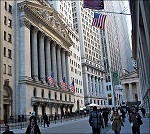Courtesy of Pam Martens
The current fragmented, opaque, and deeply conflicted structure of the U.S. stock market as well as the structure of the giant Wall Street banks that interact in every imaginable way with capital formation in America, is not in the public interest, the national interest or in the interest of capitalism itself.
Let’s start with the structure of the stock market. Those quaint video clips that you see on television of traders mulling about on the floor of the New York Stock Exchange at 11 Wall Street in Manhattan, as executives from some new company that just listed its shares ring the bell to begin stock trading, is meant to lull the public into a sense of confidence that humans are still in charge and looking out for your retirement investments in your 401(k) or public pension plan.
But 11 Wall Street is no longer the epicenter of stock trading in the United States. The truth is, there is no epicenter but rather a sprawling, opaque global network of Dark Pools owned by the big Wall Street banks trading stocks in darkness; the same Wall Street banks trading stocks in a system known as “internalization”; and more than a dozen stock exchanges, the names of which are unknown to the average American.
In a June 3 speech by Brett Redfearn, the Director of the Division of Trading and Markets at the Securities and Exchange Commission (who is, himself, legally ensnarled in this mess of a market), he described the U.S. market as follows: there are 13 stock exchanges that “collectively execute around 63 percent of volume in U.S. listed stocks but “no single exchange has even a 20 percent market share.” Then there are 32 Dark Pools, also known as “Alternative Trading Systems (ATSs)” which Redfearn politely describe as allowing “their participants to interact in a more discreet fashion.” In fact, the SEC and other regulators have repeatedly charged these secretive Dark Pools, which are owned by the biggest banks on Wall Street, with gaming the system. (See related articles below.) And yet, the Dark Pools continue to flourish under the nose of the SEC.
While television serves up those quaint men in trader jackets on the floor of the New York Stock Exchange like a comfort blanket to disarm the psyche of the American people, Redfearn goes on in his speech to describe where the real action is taking place:
…




